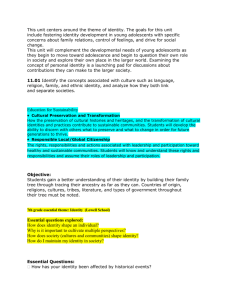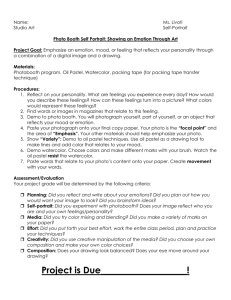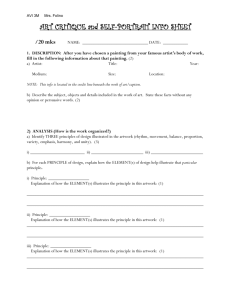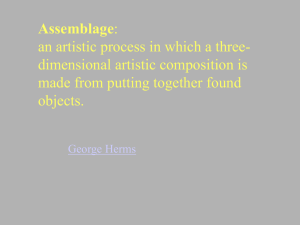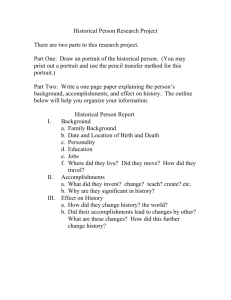George Washington Lansdowne Portrait Symbolism
advertisement
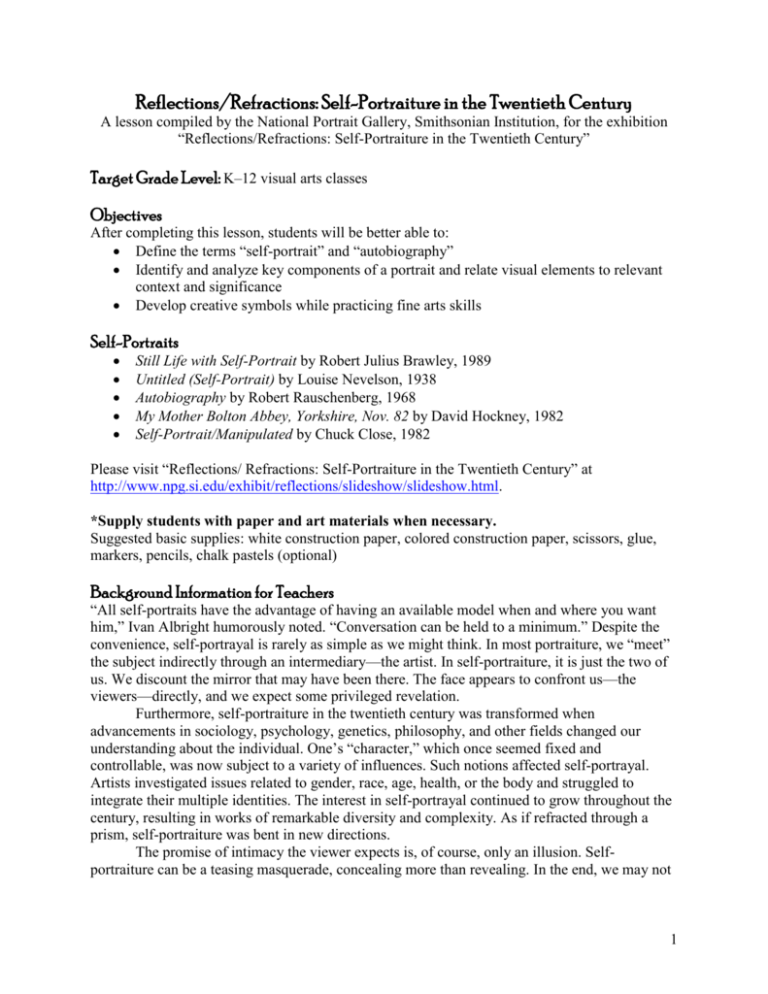
Reflections/Refractions: Self-Portraiture in the Twentieth Century A lesson compiled by the National Portrait Gallery, Smithsonian Institution, for the exhibition “Reflections/Refractions: Self-Portraiture in the Twentieth Century” Target Grade Level: K–12 visual arts classes Objectives After completing this lesson, students will be better able to: Define the terms “self-portrait” and “autobiography” Identify and analyze key components of a portrait and relate visual elements to relevant context and significance Develop creative symbols while practicing fine arts skills Self-Portraits Still Life with Self-Portrait by Robert Julius Brawley, 1989 Untitled (Self-Portrait) by Louise Nevelson, 1938 Autobiography by Robert Rauschenberg, 1968 My Mother Bolton Abbey, Yorkshire, Nov. 82 by David Hockney, 1982 Self-Portrait/Manipulated by Chuck Close, 1982 Please visit “Reflections/ Refractions: Self-Portraiture in the Twentieth Century” at http://www.npg.si.edu/exhibit/reflections/slideshow/slideshow.html. *Supply students with paper and art materials when necessary. Suggested basic supplies: white construction paper, colored construction paper, scissors, glue, markers, pencils, chalk pastels (optional) Background Information for Teachers “All self-portraits have the advantage of having an available model when and where you want him,” Ivan Albright humorously noted. “Conversation can be held to a minimum.” Despite the convenience, self-portrayal is rarely as simple as we might think. In most portraiture, we “meet” the subject indirectly through an intermediary—the artist. In self-portraiture, it is just the two of us. We discount the mirror that may have been there. The face appears to confront us—the viewers—directly, and we expect some privileged revelation. Furthermore, self-portraiture in the twentieth century was transformed when advancements in sociology, psychology, genetics, philosophy, and other fields changed our understanding about the individual. One’s “character,” which once seemed fixed and controllable, was now subject to a variety of influences. Such notions affected self-portrayal. Artists investigated issues related to gender, race, age, health, or the body and struggled to integrate their multiple identities. The interest in self-portrayal continued to grow throughout the century, resulting in works of remarkable diversity and complexity. As if refracted through a prism, self-portraiture was bent in new directions. The promise of intimacy the viewer expects is, of course, only an illusion. Selfportraiture can be a teasing masquerade, concealing more than revealing. In the end, we may not 1 gain any personal insights. For all our attempts to grasp the specific, it may be something more universal that moves us: the mysteries of human expression, connection, and understanding. Portrait Inspirations Activity This lesson is about five artists and the ways they have chosen to represent themselves in portraits. The teacher chooses how many and which “Options” to do in the classroom. Each “Option” includes first reading a self-portrait by a particular artist, then creating a self-portrait in the style of that artist. Teacher Prep: Familiarize yourself with the self-portraits listed above from the exhibition “Reflections/Refractions: Self-Portraiture in the Twentieth Century.” Warm-up: Define “self-portrait” and “symbol” with students. Portrait Reading Formula for Students: 1. Look at the portraits and analyze them using the Reading Portraiture Guide for Educators. 2. Gather biographical facts from the portrait’s symbols, and construct the context of the sitter’s life. 3. Use web resources and available books to research the sitter’s life and historical contributions. 4. Share and compare the facts gathered from the portrait with the researched facts. *Each of these steps can be done as a class, in small groups, or individually.* *Refer to “OPTIONS” in this lesson plan for “Reading Portraiture” questions relevant to specific portraits. Before the students begin their art projects, ask the question, “Why do so many artists choose to make self-portraits?” Consider notions of personal identity, self-expression, and a legacy to leave to others. OPTION 1: In the style of Robert Julius Brawley Lead students in a discussion to interpret the symbols in Brawley’s Still Life with SelfPortrait. Questions to consider: o What symbols are found in the portrait? What do these symbols tell you about Brawley? o What was the artist trying to convey about himself by including each of these symbols? How does he see himself? o How does he reveal his identity? Conceal it? Have students brainstorm about what symbols they would include in their own selfportrait. What are your interests? What is most important to each of them? Their symbolism should represent their likes and dislikes, and reflect their life in general. Distribute art supplies: white construction paper (for background), colored construction paper, scissors, glue, markers. Have students draw symbols or cut them out from the colored construction paper. Have students share their self-portrait with the class, explaining the significance of their symbols. 2 OPTION 2: In the style of Louise Nevelson Distribute copies of Untitled (Self-Portrait) by Louise Nevelson. Have students discuss the style of this portrait. Questions to consider: o How has Nevelson rendered herself? (line drawing) Why do you think she rendered herself in this way? o What adjectives would you use to describe her self-portrait? o How do you think Nevelson was feeling when she drew this self-portrait? If she had used no color or a color other than red, how would her mood seem different? Have students use white paper and a pencil to create a line drawing of themselves. Have them use a few lines of one color to express their mood. They may need to look at a picture of themselves or use a mirror. Follow-up: How can lines or brushstrokes communicate a feeling? How can color communicate a feeling? Have students write a museum label that describes how they were feeling when they made their self-portraits and how they expressed those feelings. OPTION 3: In the style of Robert Rauschenberg Distribute copies of Robert Rauschenberg’s Autobiography Have students discuss the style of this portrait. Questions to consider: o How is this portrait different than Brawley’s or Nevelson’s? How is it similar? o How does Rauschenberg use words and images? o What insight do you gain about the story of Rauschenberg’s life? Discuss self-portraiture as a way of storytelling or as autobiography by asking students, “How can a portrait communicate a story?” Have students brainstorm about various events from their lives that have been the most influential in shaping who they are today. Students could choose three, as in Rauschenberg’s portrait, or any limited number of events. Provide students with the appropriate number of sheets of white paper according to how many scenes they wish to render. Distribute colored construction paper, scissors, glue, and markers for students to create their autobiographies using images (and a few words, if they choose). Students should then share their work with the class. Follow-up: Rauschenberg entitled his self-portrait “Autobiography.” What is the significance of this title, versus calling it a self-portrait? What title would you give to your self-portrait? Why? OPTION 4: In the style of David Hockney Distribute copies of David Hockney’s My Mother Bolton Abbey, Yorkshire, Nov.82 Have students discuss the style of this portrait. Questions to consider: o Why do you think Hockney has included his mother? o What is the significance of the setting? (location where his parents courted, recent death of his father, cycle of life’s events) o How is this image different from other photographs? (photographic collage) 3 Students should brainstorm to come up with a place that tells a story about their life or another person to include in their self-portrait. Have students use a disposable or digital camera to create a photographic collage selfportrait in a significant setting or with someone who is important to them. Students may choose to include themselves prominently or inconspicuously in the self-portrait. Have students share their work with the class. Extension: Have students blindly exchange their artworks and try to guess the artist of each photographic collage. Follow-up: As a class, discuss with students why they chose this particular setting or person to include in their self-portrait. Write a letter to this person describing their influence on your life. OPTION 5: In the style of Chuck Close Distribute copies of Chuck Close’s Self-Portrait/Manipulated Have students discuss the style of this portrait. Questions to consider: o How is this portrait different than Brawley’s? (no objects, grid) o What was Close’s point of reference in creating this portrait? (photograph) o Why might this portrait be considered realistic? Have students use white paper, pencil, and charcoal to create a grid self-portrait. o Students should select a black-and-white photograph of their face. Have students use a pencil and a ruler to draw a grid on the photograph. Each line of the grid should be at 0.5 cm intervals. (To preserve the photograph, the grid can be drawn in ink on an overhead transparency taped to the photograph.) o Number the rows and letter the columns of the grid. This will help the student stay organized when copying each square to the white paper. o Have students use a pencil to lightly draw a grid on white paper. This grid should have the same number of rows and columns as the grid on the photograph. The intervals between each line will depend on the size of the white paper. There may be excess paper if the proportions of the photograph and the paper are different. Be sure to number and letter the rows and columns exactly like the grid on the photograph. o Have the students use charcoal or a soft pencil to shade in each square on the white paper according to the predominant shade of the corresponding photosquare. Each square should be a solid shade of white, gray, or black. The students should start with the darkest squares first to establish the range of shades for their self-portrait. They can use an eraser to clean up edges or lighten squares. o Once finished, students may decide to smudge the lines of the grid, using their fingers to give added expression to the self-portrait. Have students share their work with the class. Follow-up: Self-Portrait/Manipulated was a collaboration. Chuck Close designed the image and smudged the grid with his fingers after its completion. Another artist made the liquid paper-pulp and filled in the grid according to Close’s specifications. Why does Close consider this artwork a self-portrait? Based on your knowledge, do you consider it to be a self-portrait? 4 For any of the above activities, students can come up with creative titles in order to give more insight into their self-portraits. National Standards of Learning Visual Arts Standards Grades K–12: NA-VA.K-4.1 Understanding and Applying Media, Techniques, and Processes NA-VA.K-4.2 Using Knowledge of Structures and Functions NA-VA.K-4.3 Choosing and Evaluating a Range of Subject Matter, Symbols, and Ideas NA-VA.K-4.5 Reflecting Upon and Assessing the Characteristics and Merits of Their Work and the Work of Others Key Terms Autobiography: A history of a person’s life written or told by that person Collaboration: Two or more people working together to create a product Line drawing: A drawing in which the artist uses only solid lines to compose an image without shading Photographic collage: Multiple photographs pasted together on a surface to create a larger photographic artwork Self-Portrait: A likeness of a person, especially one showing the face, which is created by an artist Still life: A work of art depicting inanimate objects, often with symbolic meaning Symbol: Something representing something else by association; objects, characters, or another concrete representation of an abstract idea, concept or event 5

